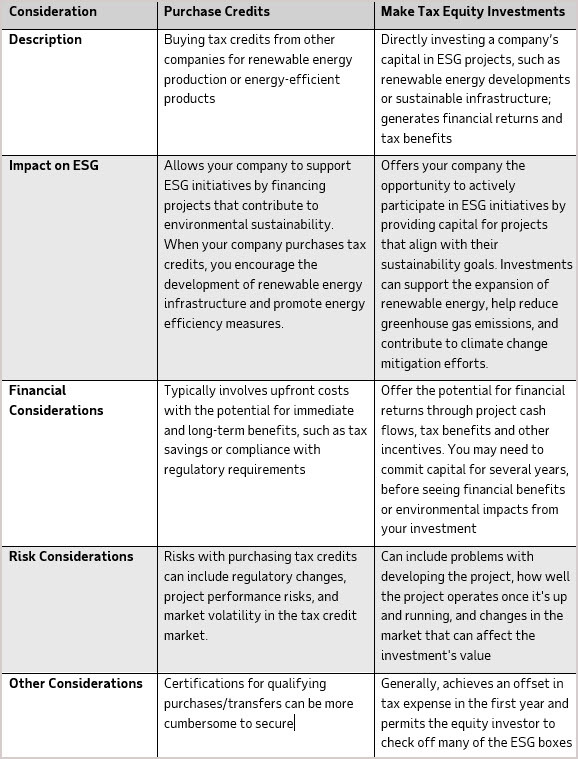New IRS Regulatory Guidance: An Update on Environmental, Social and Governance (ESG) Considerations

This is a Part 2 follow-up to our first blog on ESG. It provides updates on recent guidance for what your company's ESG goals might include through 2030 and compares the purchase of transferable credits vs. a tax equity investment in qualifying projects.
Environmental, Social, and Governance (ESG) concerns dominate many organizations' business goals, but figuring out a strategy to meet those varying goals can be difficult. Businesses should assess their ESG strategy by including the perspectives of their organization's Finance, Real Estate, Treasury and Tax departments because each has unique concerns regarding ESG-related activities, and all should be involved in goal setting.
- Finance is concerned with assessing the costs and benefits associated with ESG investments, including how ESG performance influences stock prices, investor perception and access to capital.
- Real Estate cares about how ESG initiatives affect property values, tenant satisfaction and retention, and compliance with ESG-related regulations, which can include building codes, energy efficiency and green building certifications.
- Treasury evaluates how ESG performance impacts preferential treatment when it comes to financing, financial stability, risk management and cash flows.
- Tax looks at tax incentives and credits associated with ESG activities, compliance with ESG tax-related regulations and considers the impact of transfer pricing policies vs. tax equity investments.
Let's look at how companies are approaching Scope 2 emissions, which result from the electricity, steam, heat and cooling your company purchases, through 2025 and from 2026-2030.
Understanding your company's goals for Scope 2 emissions
ESG Scope 2 emissions are indirect greenhouse gas emissions that result from your company's use of purchased or acquired energy such as electricity, steam, heat or cooling. Monitoring, managing and reducing Scope 2 emissions should be an important aspect of your organization's sustainability and ESG strategy. Here are some key considerations when setting goals through 2030.
Goal setting through 2025
When setting ESG Scope 2 goals through 2025, your company should align its goals with sustainability objectives and consider such items as:
- Establishing a baseline of current Scope 2 emissions to set future reduction goals
- Understanding and monitoring regulatory requirements and new legislation to ensure compliance and demonstrate your company's commitment to sustainability
- Assessing advancements in renewable energy and energy-efficient technologies and adopting those that can help achieve your company's goals
- Evaluating the costs associated with implementing renewable energy projects or purchasing renewable energy certificates (RECs)
- Increasing the proportion of renewable energy in your company's energy mix
- Establishing robust monitoring and reporting mechanisms to track progress toward meeting your company's Scope 2 goals.
Goal setting from 2026-2030
As you begin to outline your ESG Scope 2 goals for 2026-2030, here are some things to consider:
- Aligning ESG goals with long-term targets for reducing emissions, such as those outlined in international agreements like the Paris Agreement
- Incorporating emerging technologies that can help your company leverage the latest innovations to reduce Scope 2 emissions more effectively
- Transitioning certain business operations to 100% renewable energy or at least significantly achieving increases in renewable energy sources by 2030
- Developing comprehensive decarbonization strategies that not only include purchasing renewable energy but can also help your company improve energy efficiency, invest in energy storage solutions, and explore alternative low-carbon energy sources
- Assessing how climate change events, (i.e., extreme weather events, resource scarcity) may affect the company's operations and energy-sourcing strategy
If your company considers these factors, you can set ambitious yet achievable and cost-effective, Scope 2 goals from now through 2030 that contribute to your comprehensive sustainability agenda and help contribute to a low-carbon future.
Evaluating the purchase of transfer credits vs. a tax equity investment
Encompassed in the Inflation Reduction Act of 2022 and the final corresponding regulations, companies can now either purchase annual tax credits from another company or make tax equity investments for qualifying projects invested in renewable energy. Each alternative can support your company's ESG goals by providing financial incentives for engaging in initiatives that promote environmental sustainability.
Choosing between the two depends on your company's investment objectives, risk tolerance and strategic alignment with ESG priorities. You need to carefully assess the potential benefits and risks of each option to make informed decisions that maximize both financial benefits and ESG impact.

Deciding whether to purchase tax credits or make tax equity investments really depends on your company's investment objectives, risk tolerance and which one best aligns with your ESG strategy.
Financial reporting and disclosures
Companies can provide ESG-related financial reporting in several ways:
- Sustainability reports that focus specifically on their ESG initiatives and their performance
- In a section of the company's Annual Report that's dedicated to ESG goals, initiatives and performance
- Standalone sustainability reports that include environmental metrics (i.e., carbon emissions, energy usage, and waste management), social impact (i.e., diversity and inclusion, labor practices and community engagement), and governance practices (i.e., board composition, executive compensation and ethical standards)
- Corporate websites and communications, such as press releases
As investor interest in ESG issues continues to grow, an increasing number of public companies are using SEC filings to disclose ESG-related information to investors, regulators and other stakeholders. By incorporating relevant disclosures into their SEC filings, companies can provide transparency and accountability around their ESG performance and practices.
ESG initiatives have become increasingly important for corporations today because of growing expectations from investors, customers, employees and communities for corporations to conduct their businesses sustainably. By embracing ESG initiatives, your company demonstrates that it is committed to sustainable business practices, which will benefit its long-term success.
For additional guidance on ESG updates, please register for our webcast titled, "Greening Your Bottom Line: Monetizing the Power of ESG and Tax Incentives," which will take place on April 24, 2024, at 2:00 p.m. ET



